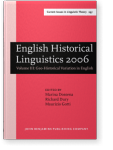Northern Middle English: Towards telling the full story
The purpose of this article, which is part of an ongoing research project on the history of Northern English, is to give more detailed information about these varieties in the Middle English period, which may serve to modify the somewhat simplistic and general views found in most histories of the language. Traditional accounts of the Northern dialects usually consist of a list of features, such as thir and tha(s) as the plural of the demonstratives, -s as the inflexion for 3sg. present indicative and present indicative plural, ar, er as the forms for the present indicative plural of be, etc. However, the analysis of early and late Middle English texts and the linguistic profiles in LALME reveals a much more complex picture: more variants have been found than those which have been regarded as typically Northern, and in some cases their distribution seems to depend on the geographical area and the type of text.
Cited by (2)
Cited by two other publications
[no author supplied]
2013.
Reference Guide for Varieties of English. In
A Dictionary of Varieties of English,
► pp. 363 ff.

This list is based on CrossRef data as of 11 july 2024. Please note that it may not be complete. Sources presented here have been supplied by the respective publishers.
Any errors therein should be reported to them.
